Bonsai cultivation offers a fascinating way to create miniature versions of full-sized trees, including the captivating Acer palmatum, also known as the Japanese maple. Whether you’re a novice or an experienced bonsai enthusiast, this article will guide you through the steps to transform a regular Japanese maple into a beautiful bonsai masterpiece. By applying techniques like pruning, wiring, and repotting, you can turn a nursery-grown maple bonsai into a stunning dwarf tree that will grace your home or garden.
The bonsai maple tree featured in this article is approximately 10-15 years old, and the styling process involves carefully pruning branches and wiring them into the desired position. The top of the tree is cut off, leaving behind a short trunk that will allow new shoots and branches to emerge in the following spring. Wiring the main branches and working up the tree is a crucial step in shaping the Japanese maple bonsai.
Key Takeaways
- Bonsai can be created from nursery stock, seeds, or ready-made bonsai trees
- Pruning, wiring, and repotting techniques are used to shape the maple bonsai
- The top of the tree is cut off to encourage new growth and branch development
- Wiring the main branches is an essential step in shaping the bonsai maple tree
- The article focuses on creating a bonsai from a 10-15 year old Japanese maple
Introduction to Bonsai Maple Trees
The origins of bonsai can be traced back to ancient China and Japan, where it was first developed as a way to cultivate small trees in containers. By the 8th century, this practice had spread to Japan, where it was further refined and the techniques for pruning, wiring, and shaping the trees were developed. In the centuries following its introduction to Japan, bonsai began to spread beyond its borders and become popular throughout the world.
Origins and History of Bonsai
The tools, techniques, and styles used to create bonsai began to evolve, and the most popular form is the classical style, which was developed in the 17th century. This style is characterized by its naturalistic curves and branches and its emphasis on the harmony between the tree and its container. Despite the changes in modern bonsai, its core principles remain the same – creating a harmonious balance between the tree, its container, and the surrounding environment.
The Art of Miniature Tree Cultivation
Bonsai has become increasingly popular globally, with many countries now practicing it and numerous bonsai clubs, societies, and events dedicated to the art. The Japanese Maple (Acer palmatum) is one of the most popular trees used in bonsai cultivation, with its delicate foliage and compact growth habits making it an ideal choice for the art of miniature tree cultivation.
Choosing the Right Japanese Maple Variety
Japanese maples are some of the most popular trees used in bonsai practice. There are several varieties that are commonly used, including Acer palmatum (Japanese Maple), Acer japonicum (Full Moon Maple), and Acer shirasawanum (Fullmoon Maple). These japanese maple bonsai trees are ideal for bonsai due to their longevity, fast growth, and delicate foliage.
Acer palmatum (Japanese Maple)
Acer palmatum, the Japanese Maple, is one of the most iconic species used in bonsai. This tree is famous for its spectacular spring sprouts with an intense carmine red color. Many cultivars of Acer palmatum exist in bonsai, showcasing different properties of the species, such as the Deshojo maple with its striking red leaves, the Atropurpureum Japanese maple with a deeper burgundy or purple color, and the Kiyohime maple, a dwarf cultivar with smaller leaves and a lateral growth habit.
Acer japonicum (Full Moon Maple)
Acer japonicum, also known as the Full Moon Maple, is another popular choice for japanese maple bonsai trees. This species is known for its bright green leaves that adapt well to dry climates before taking on a yellow color before falling. The Arakawa maple, a cultivar of Acer japonicum, stands out with its rough bark and unique appearance.
Acer shirasawanum (Fullmoon Maple)
Acer shirasawanum, the Fullmoon Maple, is a versatile choice for bonsai enthusiasts. This tree features vibrant color transitions from yellow to orange, as seen in the Katsura maple cultivar. The Shishigashira maple, another Acer shirasawanum variety, is known for its small, dark green leaves with tight internodes, while the Seigen maple is valued for its small size and delicate appearance with a slow growth rate.
When selecting a japanese maple bonsai, it’s important to look for a healthy specimen with a well-developed trunk and branches that matches the desired size and shape. The specific variety chosen will depend on the bonsai enthusiast’s preferences and the growing conditions in their area.
Providing Ideal Growing Conditions
Japanese maple bonsai trees thrive in a temperate climate with mild summers and cool winters. They require careful consideration of their temperature requirements and climate requirements to ensure their optimal growth and health. These delicate trees prefer a location with partial shade, as direct sunlight can scorch their delicate leaves. To protect your bonsai, it’s essential to shield them from strong winds and extreme temperatures, as they can severely damage the tree.
In addition to their temperature requirements and climate requirements, Japanese maples also have specific light preferences and shade preferences. Partial shade is the ideal situation, as it prevents leaf scorch while still allowing for enough light to support the tree’s growth and development. By providing the right balance of light and shade, you can create the perfect growing conditions for your Japanese maple bonsai.
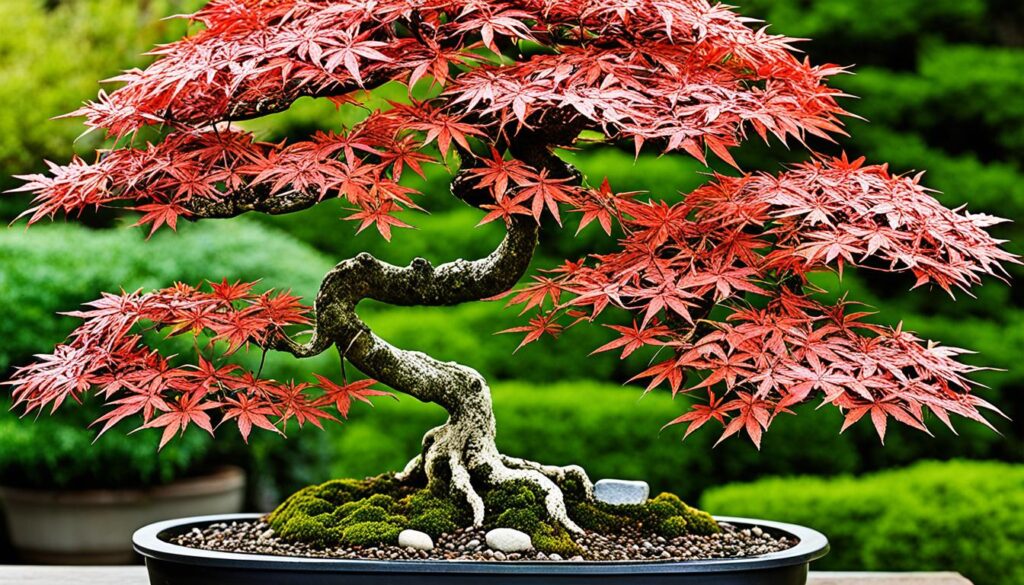
Soil Requirements for Bonsai Maple Trees
Japanese maple bonsai trees require well-draining bonsai soil mix to prevent root rot. A mix of akadama, pumice, and lava rock is commonly used for bonsai cultivation. This mixture provides good aeration and drainage while retaining enough moisture for the tree’s roots. Akadama is a type of clay that helps to hold moisture, pumice improves drainage and aeration, and lava rock adds additional drainage and structure to the well-draining soil. Using the right soil mix is crucial for the health and growth of your bonsai maple tree.
Well-Draining Soil Mix
The recommended soil mix for deciduous Bonsai trees consists of 50% Akadama, 25% Pumice, and 25% Lava rock. This combination ensures excellent drainage and aeration, which is essential for the thriving of your Japanese maple bonsai. By providing the roots with the proper growing medium, you can ensure your tree’s long-term health and vigor.
Akadama, Pumice, and Lava Rock
For coniferous and Pine Bonsai trees, the suggested soil mixture comprises 33% Akadama, 33% Pumice, and 33% Lava rock. Akadama, a hard-baked Japanese clay used for Bonsai purposes, needs to be sifted before use, and after about two years, it starts to break down, reducing aeration. The addition of pumice and lava rock helps to maintain the optimal soil structure and drainage, allowing your bonsai to thrive.
Different tree species require specific soil mixtures tailored to their needs, emphasizing the importance of checking species guides for optimal soil composition. Organic potting compost typically contains peat moss, perlite, and sand, making it ideal when combined with other components to ensure proper drainage and aeration in the Bonsai soil mix. The use of inorganic soil components like volcanic lava, calcite, and baked clays results in improved drainage and aeration, offering more control over fertilization levels.
Watering and Fertilizing Your Bonsai Maple Tree
Proper bonsai watering is crucial for the health of your Japanese maple bonsai tree. Water the tree thoroughly when the top inch of the soil feels dry. Avoid overwatering, as it can lead to root rot. Use a watering can or a gentle spray nozzle to ensure even distribution of water throughout the soil.
Japanese maple bonsai trees also benefit from regular bonsai fertilizing during the growing season. Use a balanced, slow-release organic fertilizer or a specialized bonsai fertilizer, following the manufacturer’s instructions for application rates and frequency. Avoid fertilizing during the dormant season.
Proper Watering Techniques
Maintaining proper bonsai watering is essential for the well-being of your Japanese maple bonsai. Water the tree thoroughly when the top inch of the soil feels dry, taking care not to overwater, as this can lead to root rot. Use a watering can or a gentle spray nozzle to ensure even distribution of water throughout the soil.
Fertilizer Types and Application
Japanese maple bonsai trees benefit from regular fertilizer application during the growing season. Use a balanced, slow-release organic fertilizer or a specialized bonsai fertilizer, following the manufacturer’s instructions for fertilizer types and application rates. Avoid fertilizing during the dormant season to prevent potential damage to the tree.
| Fertilizer Type | NPK Ratio | Recommended Application |
|---|---|---|
| Biogold (Organic) | 6:7:4 | Throughout the growing season |
| High Nitrogen | 10:6:6 | Spring |
| Balanced | 6:6:6 | Summer |
| Low Nitrogen | 3:6:6 | Autumn |
| High Phosphorus | 6:10:6 | To promote flowering growth |
Experts recommend using a balanced fertilizer throughout the growing season for optimal bonsai fertilizing results. The frequency and quantity of fertilizer application may vary depending on the specific fertilizer used and the stage of tree development.
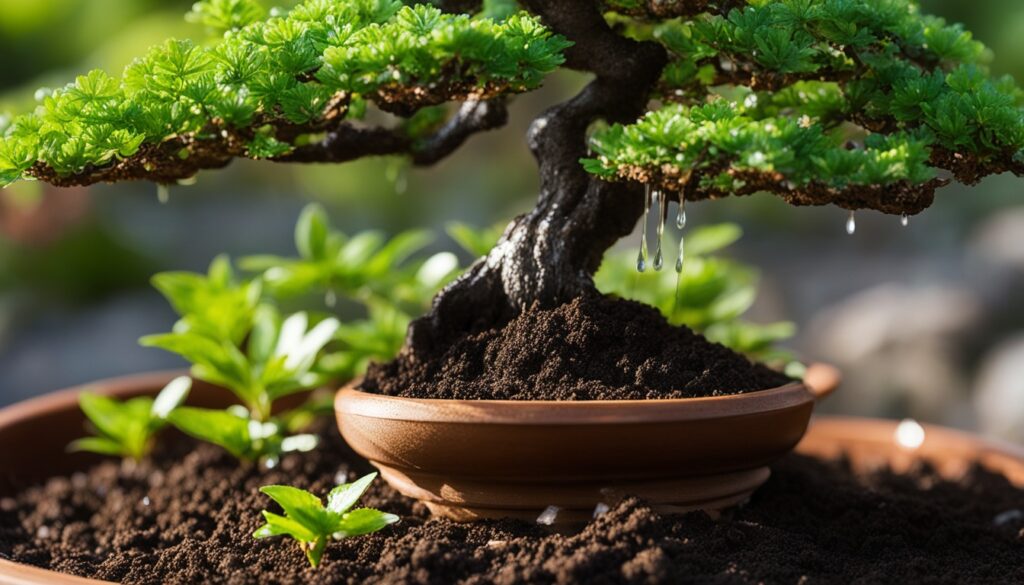
bonsai maple tree! Pruning and Shaping
Regular bonsai pruning is necessary to maintain the desired shape and size of your Japanese maple bonsai tree. Prune during the dormant season, typically in late winter or early spring, before new growth begins. Remove any dead, damaged, or crossing branches. Additionally, pinch back new growth to encourage branching and denser foliage.
Timing for Pruning
The best time for structural pruning and shaping is suggested in early to late spring. Heavy pruning should be avoided around the time of repotting to not jeopardize new growth, with at least a two-week gap recommended between heavy pruning and repotting.
Branch Selection and Wiring
Bonsai wiring is another important technique for shaping the bonsai. Start with wiring the main branches, and slowly work your way up the tree, using thinner wire for smaller, thinner branches. Proper pruning and wiring are essential for creating the desired form and structure of your bonsai maple tree.
Maples grow rapidly, leading to potential shape issues if not pruned regularly. Bonsai trees should ideally be triangular in shape, with the base offset towards the back, not centered. Pruning aims to encourage branches to grow left/right rather than up/down, and cutting back branches to buds stimulates new branch growth.
Thinning branches out for a more natural appearance is advised for bonsai maple trees. Branches that cross each other should be carefully evaluated, and one should be removed, following specific criteria. Shaping branches into an arrow-head form is recommended for bonsai tree aesthetics.
Later stages of pruning involve strategic removal of branches to boost growth and mimic natural randomness. Regularly inspecting and visualizing the tree’s shape as a triangle is recommended for effective pruning, and growth outside the triangle shape should be periodically pruned to maintain the tree’s desired form. Keeping a sketch of the tree and its triangle shape can serve as a pruning guideline for future maintenance.
Pest and Disease Management
Maintaining the health and vigor of your Japanese maple bonsai tree is essential for its long-term success. Bonsai trees are susceptible to a variety of pests and diseases that can threaten their well-being if left unchecked. By understanding the common issues and implementing proactive pest control and fungal disease prevention measures, you can ensure your bonsai maple remains vibrant and thriving.
Common Pests and Their Control
Some of the most prevalent bonsai pests affecting Japanese maples include aphids, spider mites, and scale insects. These pests can be identified by small dots, sticky residue, or a lackluster appearance in the tree. To manage these bonsai pests, consider using horticultural oils, insecticidal soaps, or targeted treatments specifically formulated for bonsai plants.
Preventing Fungal Diseases
In addition to pests, bonsai trees may also be susceptible to fungal diseases that can manifest as discolored leaves, spots, or unusual growths. Maintaining good air circulation around the tree is crucial to prevent the development of these fungal diseases. Regularly inspecting your bonsai and addressing any issues promptly can help ensure the long-term health and vitality of your Japanese maple.
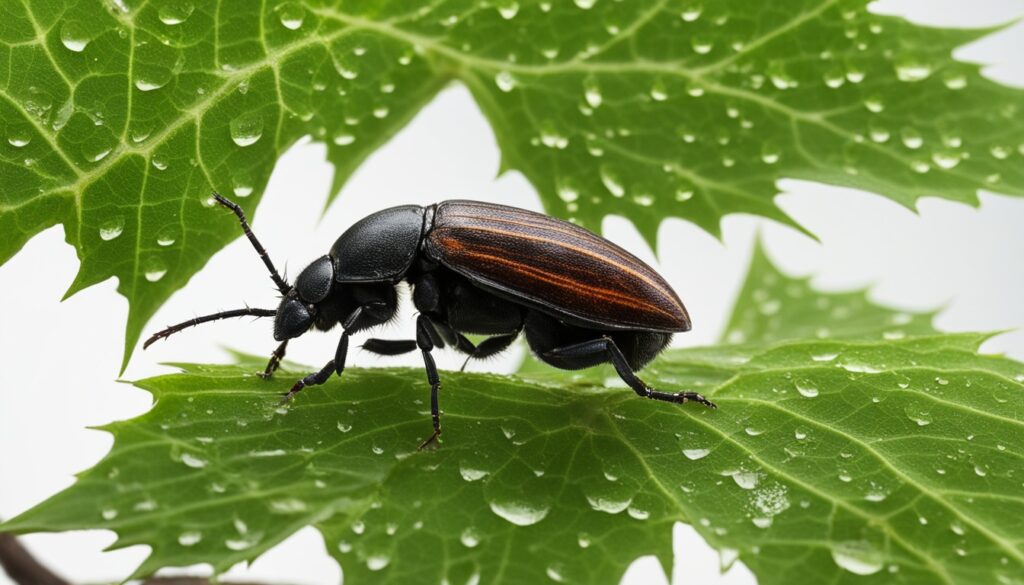
Winter Care for Bonsai Maple Trees
Maintaining the health and vitality of your Japanese maple bonsai tree during the winter months is crucial for its long-term success. As these delicate trees require protection from harsh weather conditions, it’s important to understand the proper techniques for winter bonsai care, protecting bonsai roots, and protecting bonsai foliage.
Protecting Roots and Foliage
To safeguard the bonsai roots during the winter, insulate the pot with mulch or wrap it in burlap. This helps to prevent the soil from freezing and damaging the delicate root system. Additionally, the bonsai foliage requires protection from the elements, such as strong winds and cold temperatures that can lead to desiccation and frost damage.
Sheltered Locations and Insulation
Placing your Japanese maple bonsai in sheltered locations, such as an unheated garage or a cold frame, can provide the necessary protection from the elements. In areas where temperatures regularly drop below 15°F (-10°C), keeping the bonsai in a greenhouse or cold frame is highly recommended. For milder climates with around 25°F (-4°C) at night, simply placing the bonsai on the ground can help shield it from sudden temperature drops. Bonsai insulation, such as styrofoam covers around the pot, can also be beneficial in the absence of a greenhouse or cold frame.
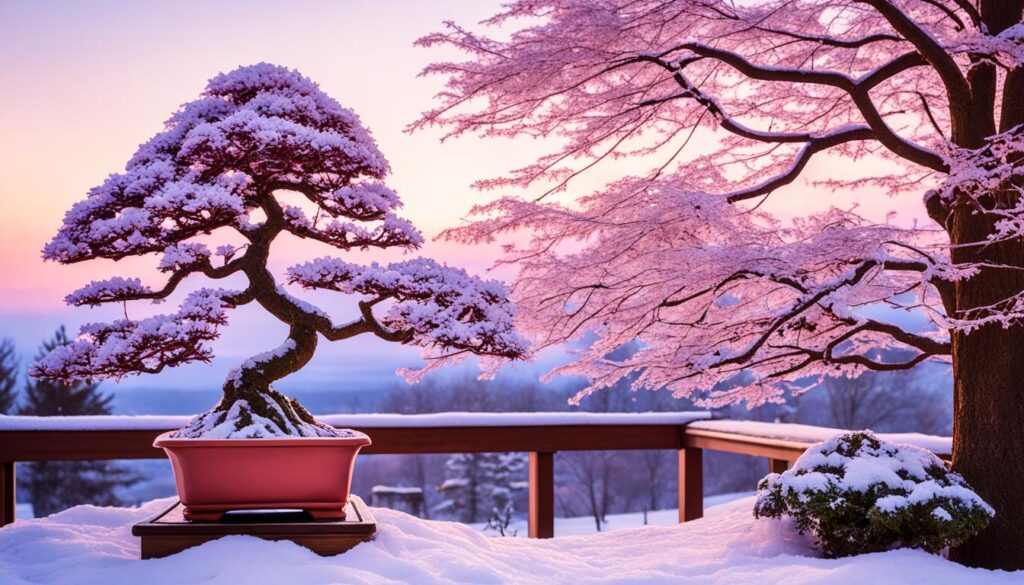
By implementing these winter bonsai care techniques, you can ensure the survival and continued growth of your Japanese maple bonsai tree, even in the most challenging winter conditions.
Bonsai Styles for Japanese Maples
When it comes to cultivating bonsai from Japanese maples, two distinct styles have emerged as the most popular among enthusiasts: upright bonsai and slanting bonsai. These styles not only showcase the natural beauty of the Japanese maple but also allow for the expression of different artistic and emotional qualities.
Upright Bonsai
The upright bonsai style is the most traditional and widely recognized among Japanese maple bonsai. This style involves carefully pruning and training the tree’s trunk and branches to create a sense of strength, stability, and maturity. The goal is to achieve a tree that appears to be standing tall and proud, much like a majestic tree found in nature. This style is often associated with a sense of tranquility and harmony, making it a popular choice for those seeking to bring a touch of serenity to their living spaces.
Slanting Bonsai
In contrast, the slanting bonsai style takes a more dynamic approach. By intentionally angling the trunk and branches, this style aims to convey a sense of resilience and weathering, as if the tree has been shaped by the forces of nature over time. The slanting bonsai can represent the ability to adapt and overcome adversity, making it an appealing choice for bonsai enthusiasts who seek to express their own strength and determination through the cultivation of these miniature Japanese maple trees.
Regardless of the specific style chosen, the cultivation of Japanese maple bonsai remains a captivating and rewarding pursuit, allowing gardeners and artists alike to explore the beauty and complexity of these remarkable trees in a truly unique and visually striking manner.
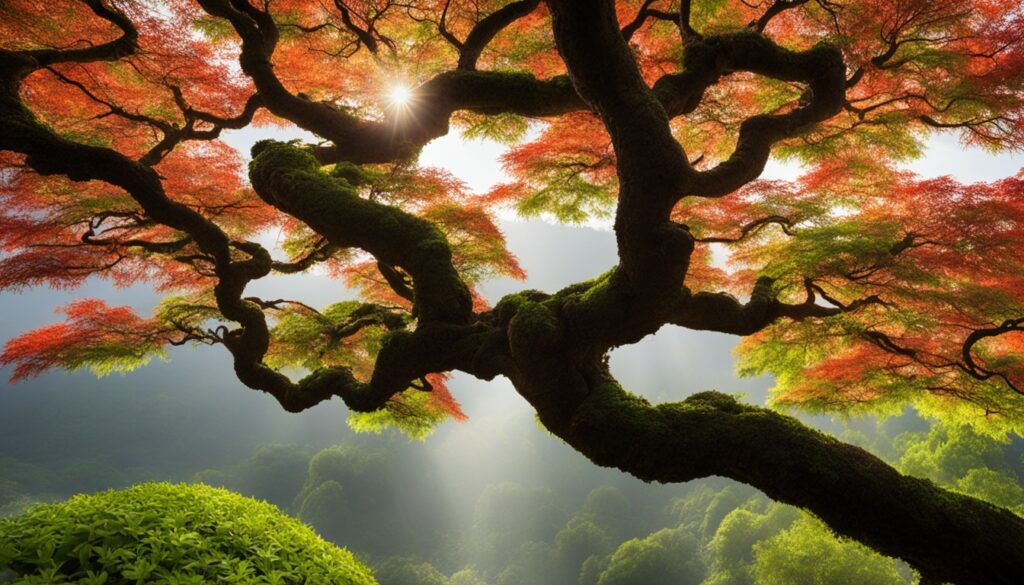
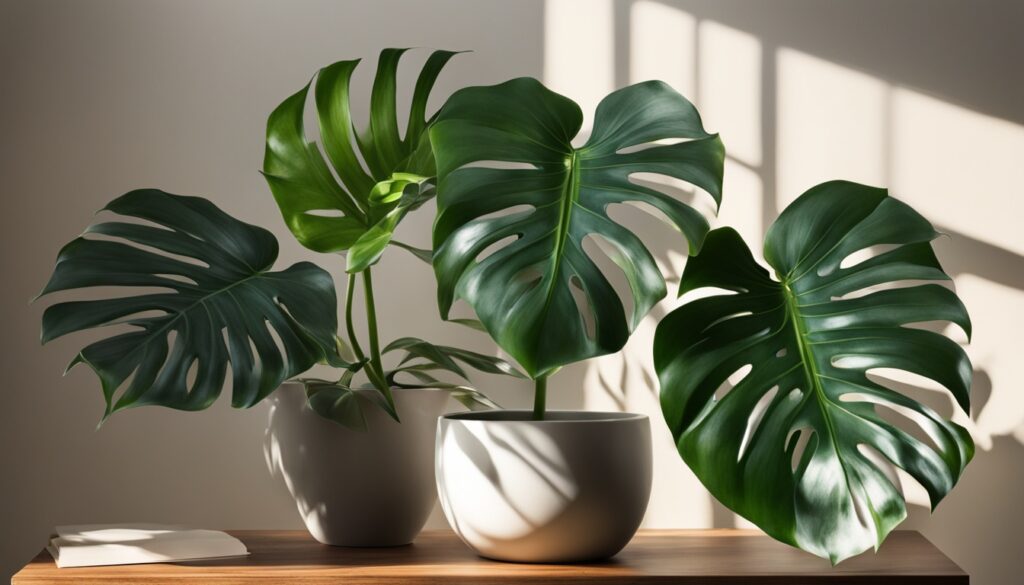

Your article helped me a lot, is there any more related content? Thanks!